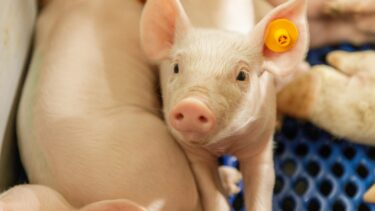Anaemia in piglets deserves adequate attention
Iron injection in piglets is a routine farrowing house treatment on pig farms that we rarely question. However, in recent years, we have seen great developments in sow farming, with ever-larger litters and piglets with a growth potential like never before. Therefore, we should be asking ourselves whether this one iron injection is still enough. In a recent study (De Backer et al., 2021) on 21 Belgian farms, 25% of the piglets were found to have clinical anaemia, and > 50% of the piglets had subclinical anaemia. It is time to reflect on this topic.
Piglets have a high need for iron, as it is an important component of haemoglobin and myoglobin. These ensure the transport of oxygen through the blood and the transport of oxygen into the muscle cells, respectively. As the weight of piglets quadruples in the first three weeks of life, piglets have a very high need for iron. Despite this high requirement, piglets are born with limited iron reserves, and colostrum and sow’s milk contain relatively low levels of iron. The amounts of iron available to produce myoglobin and haemoglobin are therefore limited compared to the piglets’ high requirements. Theoretically, a piglet needs 335 mg of iron (67 mg/kg of growth) to grow 5 kg in the farrowing house, while its reserves at birth are about 50 mg and in the daily intake is about 1 mg/day through its milk, which adds up to a deficiency of 264 mg in total. In particular, piglets in large litters (due to lower reserves) and piglets from older sows are at higher risk of iron deficiency. The faster the piglets grow, the greater the risk of an iron deficiency. Therefore, heavy, large piglets have a higher risk of anaemia at weaning, despite the iron injection in the first days of life.
The visible symptoms of severe deficiencies are pale mucus membranes, rough hair, lethargy, and a lack of appetite. But even before these clinical deficiencies, subclinical deficiencies result in a lower disease resistance and therefore a higher susceptibility to disease, with a consequent reduction in weight gain. Optimal haemoglobin levels are > 110 g/l; values between 90 and 110 g/l are suboptimal, while < 90 g/l is considered clinical anaemia. These levels can also be measured to see if the iron supply on a sow farm still meets the standards.
A Danish study (Haugegaard et al., 2008) showed that piglets that received a second iron injection at 20 days of age grew 20 grams/day faster in the first 15 days after weaning compared to piglets that received only one iron injection in the first days after birth. Another Danish study (Bhattarai et al., 2015) found that increasing piglet haemoglobin by 10 g/l at weaning resulted in increased growth of 17 g/day during the first three weeks after weaning. These are all signs that iron levels do play an important role in the health and performance of piglets after weaning.
In addition to the iron injection, the piglets’ diet can also play an important role in providing them with extra iron. With our Earlyfeed products, we want to ensure that piglets are prepared from an early age as well as possible for good and healthy growth in the later stages of life. After all, you cannot start to stimulate the health and growth of piglets early enough. A sufficient supply of iron is an important element in this. All our milk products, creepfeeds, and prestarters therefore contain a high content of an easily absorbable organic iron source. The extra easily absorbable iron from the prestarter is a welcome supplement for the piglet, especially towards the end of the farrowing period, when the piglet’s reserves, which it received from the sow and the iron injection, are exhausted. We also see that the START+ concept, which we use in our prestarters to stimulate the intestinal development of piglets in the farrowing pen, results in a better iron status of the piglets at weaning (see Table 1). After all, START+ stimulates the intestinal development and the absorption capacity of piglets, resulting in a better utilisation of the nutrients in the feed and a more efficient absorption of iron.
| Control | START+ | P-Value | |
| Fe-Serum (µg/dl) | 90.0 ± 28.4 | 110.2 ± 45.9 | 0.14 |
Our weaning concentrates also contain organic iron, to provide the piglets with an extra shot of easily absorbable iron after weaning. All this is to ensure that the piglets get a healthy start in the nursery and that their resistance to disease can be supported as best as possible.
In conclusion, it may be interesting to review the iron supply and the occurrence of (subclinical) anaemia on the sow farm. Everything that benefits the piglet’s disease resistance deserves adequate attention, especially given the pressure on antibiotic use. An Earlyfeed prestarter and weaning concentrate that helps to provide piglets with sufficient extra iron can be a welcome addition to the iron injection, thus contributing to a reduction in antibiotic use after weaning.
This contact was suggested based on the location you are browsing from. You can of course also consult our other contacts and locations here.

